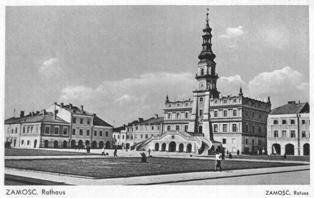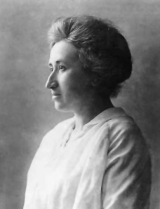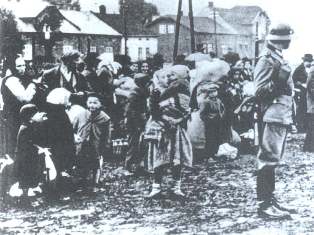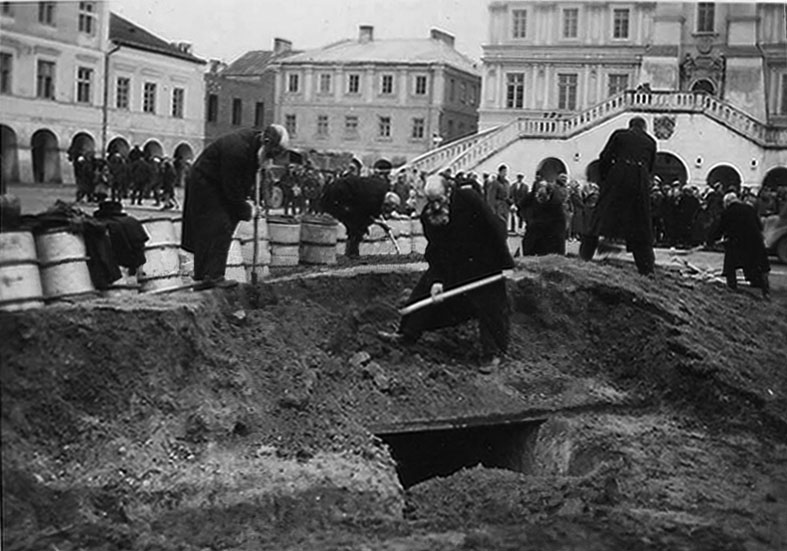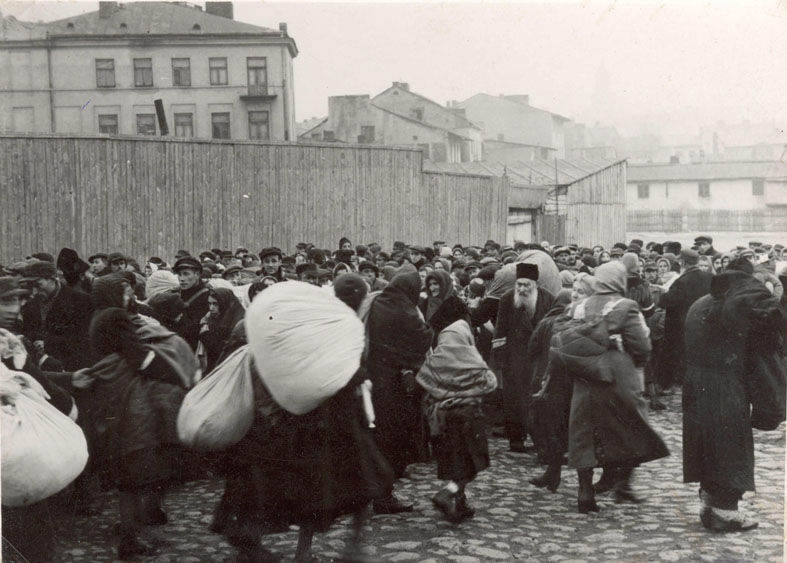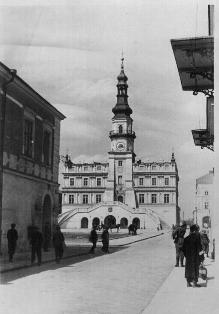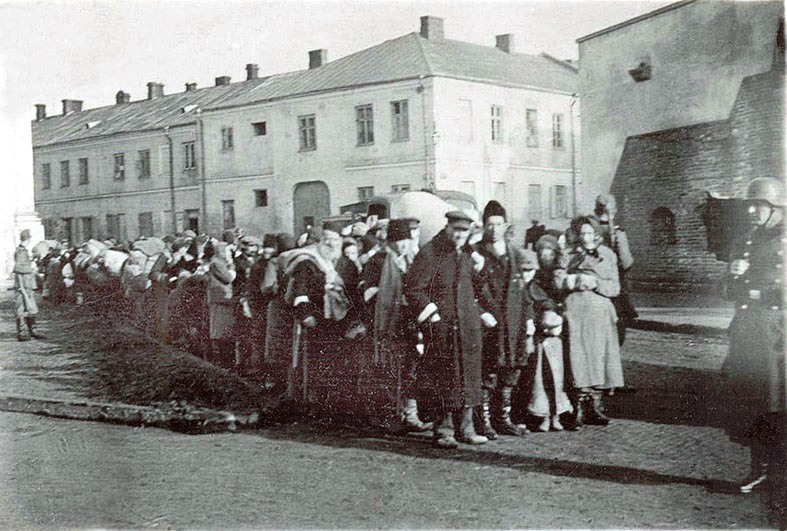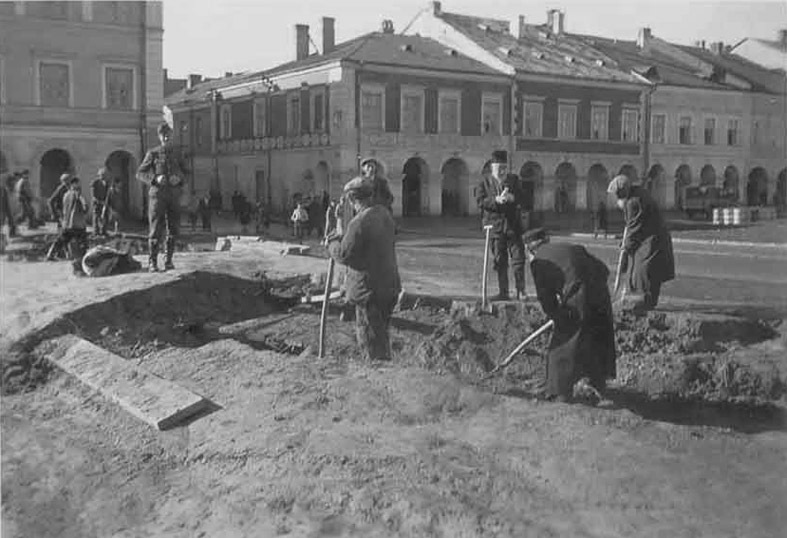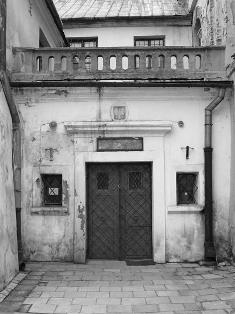Holocaust Education & Archive Research Team |
Ghettos
Zamosc Introduction to the Ghettos of the Holocaust
Jewish Ghettos The Judenrat Judenrat Leaders Prominent Jews
| |||||||||
Zamosc Ghetto
Zamosc is a unique urban complex founded at the end of the 16th century by Jan Zamoyski, the Chancellor and Grand Hetman of the Crown. Designed by Italian architect Bernado Morando, Zamosc was built from scratch as a model Renaissance town and an impregnable fortress, one of the biggest in the kingdom of Poland.
Jews settled in Zamosc from 1588, these were mainly Sephardic Jews from Turkey, Venice, Flanders and Holland. Having received a privileged status from Jan Zamoyski, they built a synagogue in a mixture of Renaissance and Baroque style. During this time this was the only religious community of Sephardic Jews in Poland.
However, in the second half of the 17th century Ashkenazi Jews were in preponderance, Sephardic Jews became assimilated or left the town following numerous wars. Jewish Zamosc marked its unique character once again at the turn of the 18th century becoming the most dynamic centre of Haskalah or the Jewish Enlightenment.
Rabbi Izrael Ben Moshe Zamosc, a famous philosopher and mathematician, was born in Zamosc. Later he moved to Berlin as an advisor to Moses Mendelsohn one of the biggest reformers of German Jewry.
The tenets of Haskalah were propounded by other distinguished men of letters from Zamosc such as Jozef Cederbaum, Jakub Eichenbaum and Doctor Shlomo Ettinger, one of the first writers in Yiddish. Finally Yitskhok Leybush Perec, one of the most eminent writers in Yiddish, was also born in Zamosc, the town where many of his works are set.
Perec’s cousins lived in Zamosc until 1942, when they shared the tragic fate of the majority of local Jews. Also another native of Zamosc was Roza Luxemburg, a social-democratic activist who was more well- known in Germany, than in her native Poland.
Before the outbreak of the Second World War some 12,500 Jews lived in Zamosc accounting for 43 per cent of the total population. The biggest concentration was in the Old Town and New Town districts, mainly around the New Town market square.
Jews controlled nealy 80 percent of the local trade, 65 percent of crafts and 54 percent of industry, Jewish political parties and associations were flourishing, along with schools, including one middle school for Jewish students. Of all Jewish papers published Zamoszczer Sztyme had the longest life.
On 14 September 1939 Zamosc was first captured by the Germans and then for two weeks by the Soviets. The arrival of the Soviets was hailed with enthusiasm because some of the Jews perceived them as the liberators from the German yoke.
The Soviets left the town at the beginning of October 1939 along with some 5000 Jews, mostly young and politically active people, not necessarily though supporters of communism. Extraordinarily, for the next 7 days the town was occupied by neither the Germans nor the Soviets, until on 7 October 1939 the Germans returned. Jews were immediately rounded up for slave labour and their property looted. In early December 1939, the Gestapo ordered the formation of a Judenrat with 12 members.
Its first chairman was Ben-Zion Lubliner, subsequently replaced in January 1940 by Mieczyslaw Garfinkel, who was a well-known lawyer in Zamosc before the war and came from an assimilated family. The Judenrat was ordered to take a census of Jews in the town and to collect the first in a series of "fines". About one month after its establishment, the number of members of the Judenrat was doubled.
According to the most recent research, about 7,000-8,000 Jews left Zamosc at that time. In accordance with plans for the massive resettlement of different ethnic groups, the Nazis began deporting Jews from the Warthegau, and eventually from other countries to Zamosc, to occupy vacant Jewish housing.
In 1940, when the first official register of the population was organised (the so-called "Judenrat list"), there were 4,000 Jews residing in the town who were originally from Zamosc and 1,000 Jewish refugees who had been resettled there. They had come from Wloclawek, Lodz and Kolo, places that had been incorporated into the Warthegau, or they had escaped from small towns destroyed in 1939, such as Janow Lubelski, Bilgoraj and Frampol.
In late 1939 or early 1940, the first restrictive edicts were introduced. Jews were prohibited from using vehicles and from leaving the town. They were also ordered to wear a white armband bearing a yellow Star of David. In June 1940, the Judenrat was instructed to register all Jewish males between the ages of 14 and 60 for labour details. Groups of workers were sent to various labour camps in the locality and in the Lublin district: Wysokie, Bialobrzegi, Janowce (where in the former agriculture school Jewish prisoners had to build an SS barracks), and "Kawaler", which was the remnant of the former Russian fortress in Zamosc.
A group were also sent to Belzec for work on the "Otto Line", a series of anti-tank ditches and artillery dugouts being constructed close to the demarcation line between German- and Soviet-occupied Poland. A large labour camp was established at Izbica in 1941, and 1,500 - 2,000 Jews from Zamosc and the region were incarcerated there.
In 1941, prior to the invasion of the Soviet Union, the Bauleitung der Luftwaffe began to build airfields at Mokre and Labunie, near Zamosc. Jewish work camps were also established in these villages. A group of Jews from the ghetto worked in these camps, which survived the liquidation of the ghetto itself. The number of Jewish workers there was enlarged in 1942. Several dozens of the Czech Jews deported to Zamosc and Izbica were sent to the camp in Labunie, which was finally liquidated in 1943 when all of the workers were executed.
In early April 1941, the Jews were ordered to move to an impoverished quarter in the New Town, the poorest district in Zamosc. In the main, before the war only Orthodox and destitute Jews had lived there. Many houses in what was to become the ghetto had been destroyed in the early days of the war, and those that remained were extremely dilapidated. The conditions of life were very primitive.
In 1941 when the Zamosc Jews had to move into New Town, many houses there were empty. It was from this part of the town that most of the Jews had escaped to the Soviet Union. The deadline for moving was 1 May 1941. The Judenrat conducted a census immediately after the establishment of the ghetto and discovered that it contained 7,000 Jews. The ghetto was not "closed", but exit from it by Jews was only permitted at certain times. Poles, on the other hand, were allowed access to the ghetto, which helped to ameliorate the usual drastic shortages of food and other essentials common to all ghettos. Until June 1941 and the German invasion of the Soviet Union, there was even a functioning post office in the ghetto.
At the end of March and in early April 1942, rumours began to circulate in the ghetto concerning mass deportations from ghettos in the Lublin area to the extermination camp at Belzec.
Garfinkel received a telephone call from members of the Lublin Judenrat, advising him of the deportations. After contacting the Jewish communities of Tomaszow Lubelski and Belzec itself, he was given to understand that 10,000–12,000 Jews were arriving daily at the Belzec camp, a strongly guarded compound located on a special railway spur and surrounded by barbed wire. Jews were being killed there in a "puzzling manner". Garfinkel did not believe the reports, even when he received confirmation of gassings at Belzec from two or three Jewish witnesses who had escaped from the camp.
On 11 April 1942, deportations from Zamosc began. Around noon of that day, the ghetto was surrounded by police and SS. In command of the deportation was Bruno Meiers, head of the Gestapo in Zamosc, although the actual chief of operations was one of his assistants, an SS-officer named Gotthard Schubert.
The Jews were assembled in the market square, where they were forced to wait without food or water until 9 p.m. Scores of Jews who were discovered hiding in the ghetto, as well as elderly and sick people, were shot in their houses or in the streets. 3,000 Jews were marched to the train station and boarded 30 wagons destined for Belzec. Behind them they left the several hundred bodies of those who had been shot.
An eyewitness to the day's events, David Mekler, recalled:
"On 11 April 1942, the SS, SD and mounted police fell like a pack of savages on the Zamosc Jewish quarter. It was a complete surprise. The brutes on horseback in particular created a panic; they raced through the streets shouting insults, slashing out on all sides with their whips.
Our community then numbered 10,000 people. In a twinkling, without even realizing what was happening, a crowd of 3,000 men, women and children, picked up haphazardly in the streets and in the houses, were driven to the station and deported to an unknown destination.
The spectacle, which the ghetto presented after the attack, literally drove the survivors mad. Bodies everywhere, in the streets, in the courtyards, inside the houses; babies thrown from the third or fourth floor lay crushed on the pavements. The Jews themselves had to pick up and bury the dead."
Also among the deportees was Moshe Frank, who at that time was 13 years old. Together with his mother he was taken to the ramp (called before the war the "beetroot ramp"), located between the Old Town and the New Town and from where all deportations took place:
“Jews stood on the square and kept hold of the bundles that each one had taken with him from his home. We stood on this square until the evening. It was only in the evening that the Germans harried us to the cattle cars of death. They forced us to the wagons us with great terror.
There were shots, crying children and mothers, screams all along the way. Whoever couldn't walk, whomever left the crowd, whoever turned a child's head, was shot and tragically killed. At last we were on the ramp where the cattle cars waited for us. They pushed the Jews towards the train and then came the moment when I had to enter the wagon. The Gestapo man pushed me towards the cattle car. I did not think very long. Instead of boarding the train,
I shoved myself under the cattle car and crawled under some sheet metal by the railway line, where I waited until all of the Jews were in the train. Later I crawled in the direction of the street and escaped to New Town.
On the way I saw body after the body. The whole street was covered in Jewish bodies: one still held his bundle, a second had abandoned his, a third was wounded in the breast, a fourth in the head. I walked to New Town and in the streets everything resembled the aftermath of the Jewish Flood."
The 13 year-old son of a council functionary, Lejb Wolsztejn, had been among the deportees. On reaching Belzec, he had managed to hide in a latrine pit. He had witnessed the entire killing operation, but eventually managed to leave the pit and escape from the camp.
The youth made his way back to Zamosc the next day and reported what he had seen to Garfinkel. His story was not believed either. It seemed impossible that so many people had been murdered, and not sent to labour camps in the east, as the Germans claimed. During this "action" about 300 people were killed in the ghetto and on the way to the ramp. Among those killed was the sister of I. L. Peretz, Hessa Goldstein, who was shot at her home.
Moshe Shklarek, not quite 15 years of age and one of the 64 survivors of Sobibor, was deported to that camp from Zamosc on 17 April 1942, together with 2,500 other Jews. 2,100 deportees arrived in Zamosc from the "Protectorate" in spring 1942 and were soon joined by German Jews from Dortmund and Westphalia. Among the Jews from Dortmund was Alwin Lippmann, together with his wife and daughter.
During World War One he had been a famous German pilot and a personal friend of Hermann Göring. Shortly after his arrival, Lippmann was appointed to the position of commandant of the Jewish police in Zamosc.
On 17 May 1942, the "Old People's Action" began in Zamosc. The Judenrat issued a proclamation on the walls of houses, stating that every elderly Jew had to present themselves at the appointed place, together with their clothing and food for three days. In accordance with the list that had been drawn up, "they will be resettled". Families tried to rescue their own parents and grandparents and many people built hiding places in their homes.
At this time the Jewish police rounded up the old people, who were gathered in the "Judenrat prison". Garfinkel refused to release even the parents of his friends, explaining that "if the old people are not resettled, we will all be resettled."
Over the next 10 days, elderly Jewish residents were rounded up and sent to Belzec. After this "action" there were 4,700 – 4,800 Jews left in Zamosc, among them about 1,000 from Czechoslovakia and Germany.
In the spring of 1942, the first mass executions of members of the Jewish intelligentsia, accused of making contact with Communists, took place at the Rotunda in Zamosc. There were to be many further executions at the Rotunda. Among the victims were Jewish prisoners from the work camps in Zamosc and many Poles from pacified villages.
There followed a period of relative quiet in the ghetto, until on 11 August 1942 the deportations resumed. SS officers from the Headquarters of Aktion Reinhard participated in this "resettlement".
At their head was Amon Göth who was later to become the commandant of the Plaszow concentration camp in Krakow. As with the earlier "actions", all Jews were supposed to gather in the market square in New Town, but many people who were aware that "resettlement" meant transport to Belzec tried to hide.
Göth had ordered that 2,000 people should be gathered for the transport, but only 250 assembled in the market square, so the SS men rounded up the next 100 people from the work camps and included some of the members of the Judenrat and their families.
This was the first time members of the Judenrat were not exempted from the "action". On this occasion, Garfinkel "negotiated" the cessation of the "action" with Göth. The SS officer obtained "a gift" from the President of the Judenrat: 30,000 zlotys, 1 kg of coffee and 1 kg of tea, all presented in an elegant suitcase. The people arrested during this "action" were deported to Majdanek concentration camp. As with the earlier "actions", many people were killed on the spot.
Among them were the advocate Julian Goldstein and his wife and daughter. Goldstein, who was the nephew of I. L. Peretz and was also a member of the Judenrat, refused to be transported and asked one of the cruellest SS men in Zamosc, who was also the commandant of the work camp in Janowice, Hans Pienkowski, to execute him and his family at the market square. Pienkowski personally killed them all.
The deportations continued on into early September 1942. The final liquidation of the ghetto began on 16 October 1942. An estimated 4,000 Jews were assembled on the market square. 300 were left to sort the possessions of the deportees. The rest were marched 21 km to Izbica which was at that time not only a main transit ghetto for foreign Jews, but also a gathering point prior to deportation for Polish Jews from Krasnystaw and Zamosc counties.
Many deportees from Zamosc were shot en-route to Izbica. It was not possible to find shelter in Izbica for all of those who remained. They were held in the open air without any sustenance. Jekutiel Cwilich, a survivor from Zamosc, described the situation in Izbica:
"The Jews arrived in Izbica at night. There were already many other Jews there, including some from Czechoslovakia and others from small towns near to Izbica. There were many people sitting on their suitcase in every house where it had been possible to gain entrance. The streets were full of people who sat and slept on suitcases. Izbica looked like a big railway station with everybody awaiting the train." In batches, they were sent to Belzec and Sobibor.
Rudolf Reder, a survivor of Belzec provided written testimony, in which he described the arrival of a train from Zamosc on 15 November 1942:
"It was cold. The ground was covered with snow and mud. In such conditions and in the middle of a snowstorm, a big transport arrived from Zamosc.
The whole Judenrat was on the train. When they had all undressed and stood naked, as usual, the men were pushed towards the gas chambers and the women to the barrack-hut to have their heads shaved.
But the leader of the Judenrat was ordered to stay behind in the yard. The Ukrainian guards took the transport away and the complete Belzec SS detachment surrounded the Jewish leader. I don't know his name. I saw a middle-aged man, pale as death, but completely calm.
The SS men ordered the orchestra in the yard to await further orders. The orchestra - six musicians – was usually stationed in the area between the gas chambers and the mass graves. They played all the time – day after day – using instruments taken from the dead.
I was working nearby on construction work, and saw everything that happened. The SS ordered the orchestra to play "Es geht alles vorüber, es geht alles vorbei" and "Drei Lilien" on flutes, fiddles and harmonicas. This lasted for some time. Then they put the leader of the Judenrat against a wall and started to beat him about the head and face with whips. Those who tortured him were Irmann – a fat Gestapo man –, Schwartz, Schmidt and some of the Ukrainian guards.
Their victim was ordered to dance and jump around to the music while being beaten. After some hours, he was given a quarter of a loaf of bread and made to eat it – while still being beaten. He stood there, covered in blood, indifferent, very calm. I did not hear him even groan once. His torment lasted for seven hours.
The SS men stood there and laughed, "Das ist eine höhere Person, Präsident des Judenrates!" they shouted loudly and wickedly.
It was six o'clock in the evening when Gestapo man Schmidt pushed him toward a grave, shot him in the head and kicked the body on to the pile of gassed victims."
The Judenrat leader was not Garfinkel, who had escaped from Zamosc and survived the war, later living in London. It was in fact, not on 15 November 1942 but on 2 November when most of the Jews from Zamosc were deported to Belzec. In the transport, which Reder described, was Azriel Szeps vice-president of the Zamosc Judenrat.
All members of the Judenrat in Zamosc, together with their families, were deported to Belzec in the same transport. The rest of the Jews from Zamosc remaining in Izbica were killed during a mass execution in November 1942 at the Jewish cemetery.
The Nazis killed the rest of the Jews left in the Zamosc Ghetto in March 1943. Most of the remaining labour camps around Zamosc were dismantled in May 1943 and the slave labourers, numbering about 1,000 in total, were sent to Majdanek.
Among them was Mordechaj Sztrygler who survived Majdanek and after the war described his fate and the fate of the last Jews from Zamosc. Jews were not the only victims of Nazi genocidal policy in the Zamosc region. Following the decimation of the Jewish population, on 12 November 1942 the Zamosc area was declared the "First Resettlement Area" of the Generalgouvernement.
In another example of massive demographic change, the Germans evacuated 300 villages, uprooting 110,000 Polish peasants to make room for SS men and Volksdeutsche to settle in the area. 10,000 people perished in the course of this "ethnic cleansing". The survivors were sent either to camps in Zamosc and Zwierzyniec, to Auschwitz or Majdanek, to Germany for forced labour, or to villages in the Lublin and Warsaw districts. More than 30,000 children were taken away from their parents.
Some of these children died in Auschwitz or in the course of deportation; others, deemed to possess suitable racial characteristics for reclamation under a process called Eindeutschung, were screened for adoption by Nazi Party and SS members. Children had already been selected according to racial regulations in the Zamosc transit camp. The children chosen were not only told that their parents were dead – often true – but were brainwashed with stories designed to make them reject their heritage. They were given German names and indoctrinated with concepts intended to give them pride in their new racial identity. Very few of these kidnapped children were ever reunited with their real parents.
An entire group of these children, numbering approximately 4,500 in total, were sent to Lebensborn centres. Some of the children who were deported to Auschwitz were killed by phenol injection. At Majdanek many children died from starvation and thirst.
More than 50,000 Poles were deported to Germany for slave labour from the Zamosc region in the years 1942 - 1943. Numerous villages were completely destroyed.
In many of these villages, the Germans organised mass executions. The resettlement of the Poles in the Zamosc region was the beginning of mass resistance to German rule. Even the German administration called this resistance the "Zamosc uprising".
According to SS plans, Zamosc, as the principal town of the district was intended to be Germanised. Odilo Globocnik suggested changing the name of the town to "Himmlerstadt".
Heinrich Himmler refused to accept "the gift" because Hitler had not had a town named after him. Instead, the Germans changed the name of Zamosc to "Pflugstadt" (Pflug = plough).
After the war, approximately 300 Jews returned to Zamosc, most of them from the Soviet Union. They were not welcomed. At least two of them were murdered by Polish anti-Semites. Most of the Jews rapidly left the town. By 1947, there were 7 Jewish residents remaining in Zamosc.
In a post-war trial held in Wiesbaden, Schubert was sentenced to 6 years imprisonment. Meiers was acquitted. Among the sights that bear witness to the Jewish heritage is a fine synagogue in ul. Pereca, the synagogue was devastated during the war and converted into a joiners workshop, the building survived, was reconstructed, and used as a public library.
In recent years it was returned to the Jewish congregation in Krakow, with a view to establishing a museum of Zamosc Jewry. Before 1939 Zamosc had two Jewish cemeteries, the old one in ul. Partyzantow and the new one in ul. Prosta. Both were levelled to the ground during the war.
Sources:
From Lublin to Belzec by Robert Kuwalek – published by AD REM in 2006. The Destruction of the European Jews, by Raul Hilberg – published by Yale University Press, New Haven, 2003. Encyclopedia of the Holocaust, Macmillan Publishing Company, New York, 1990. Himmler – Reichsführer-SS, by Peter Padfield – published by Macmillan Publishers Limited, London, 1991. The Holocaust – The Jewish Tragedy, by Sir Martin Gilbert, published by William Collins Sons & Co. Limited, London, 1986. Holocaust Journey, by Sir Martin Gilbert – published by Weidenfeld & Nicolson, London,1997. Atlas of the Holocaust, by Sir Martin Gilbert – published by William Morrow and Company, Inc, New York, 1993. Justiz und NS-Verbrechen, Archive of the Jewish Historical Institute: M. Garfinkel: Monography of the Zamosc town. Zydzi w Zamosciu 1918-1942 (Jews in Zamosc 1918-1942), by Adam Kopciowski unpublished PhD. Everlasting Name. Zamosc Ghetto Population List – 1940, ed. E. Bar-Zeev, Tel Aviv 2001. Testimony Zamosc-Izbica, in Zycie i zaglada Zydow polskich 1939-1945. Relacje swiadkow (Life and Annihilation of the Polish Jews 1939-1945. Witness Testimonies. Frank Moshe Oficyna Naukowa, Warszawa 2003. State Archive in Lublin, Collection of Zamosc Judenrat. Archive of the State Majdanek State Museum: Sztrygler, Mordechaj, Memoirs. Holocaust Historical Society
Copyright Robert Kuwalek H.E.A.R.T 2007
|
